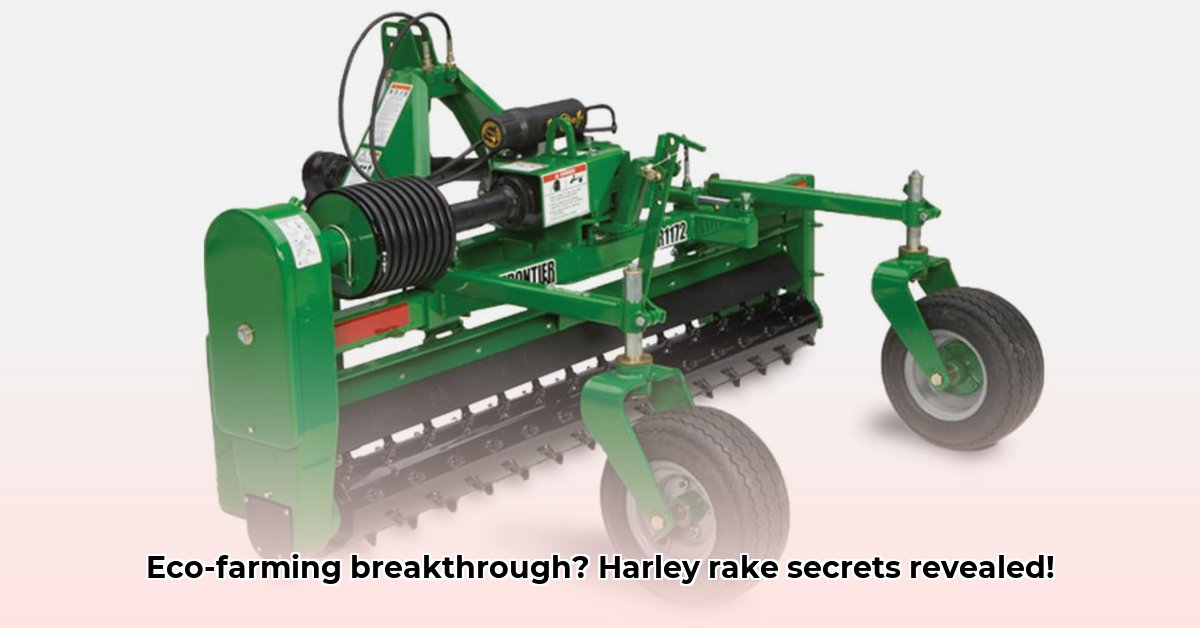
Harley Rake for Sustainable Land Preparation: A Practical Guide
This guide provides farmers with a comprehensive understanding of Harley Power Box Rakes and their application in sustainable agriculture. We will cover the benefits, implementation steps, and considerations for successful integration into your farming practices. This includes comparing the Harley rake to no-till drilling, a key consideration for modern sustainable farming. For more tractor-related information, check out this helpful resource.
Understanding the Harley Rake System
The Harley Power Box Rake is a three-point hitch attachment (attaches directly to your tractor's hydraulics) designed for efficient land preparation. Its rotating tines (metal teeth) level the ground, clear debris, and create a consistent seedbed. This leads to improved seed-to-soil contact and enhanced germination rates.
How a Harley Rake Improves Efficiency
Traditional land preparation methods are often labor-intensive and time-consuming. The Harley rake significantly reduces these limitations. By covering more ground in less time, it reduces labor costs and fuel consumption. This directly translates into a higher return on investment (ROI) and improved overall farm profitability. Are you ready to save time and money while boosting your yields?
Is a Harley Rake Right for Your Farm?
Before investing in a Harley rake, consider the following factors:
- Soil Type: The rake's effectiveness varies with soil type. Clay soils, for example, may require adjusted techniques.
- Debris Level: Large rocks or significant debris can damage the rake. Pre-clearing might be necessary.
- Tractor Horsepower: Ensure your tractor has sufficient horsepower to operate the rake effectively. Refer to the manufacturer's specifications. Underpowering drastically reduces efficiency and can damage the equipment.
- Terrain: Uneven terrain necessitates hydraulic angle adjustment to maintain consistent work quality.
Implementing Your Harley Rake: A Step-by-Step Guide
Efficient implementation is key to maximizing the benefits of your Harley rake. Follow this step-by-step guide for optimal results:
Pre-operation Inspection: Thoroughly inspect the rake for any damage or loose components. Check your tractor's hydraulic fluid levels and ensure the PTO (power take-off) is functioning correctly. A pre-operation inspection can prevent costly downtime.
Field Scouting: Walk the field to identify and remove any potential hazards, such as large rocks or debris. This preventive measure safeguards your equipment.
Initial Pass: Begin with a single pass at a moderate speed to assess the rake's performance and make any necessary adjustments to the angle or depth of operation. This allows for optimization during subsequent passes.
Fine-Tuning: Depending on the initial pass results, adjust the speed and angle to achieve the desired level of soil preparation. Multiple passes are often required for optimal results.
Post-Operation Maintenance: After each use, inspect the rake for damage or wear. Clean, lubricate, and store properly to extend its lifespan. Proper maintenance extends your investment.
Weighing the Pros and Cons of Harley Power Box Rakes
The decision to implement a Harley rake necessitates a balanced assessment of its advantages and disadvantages:
| Feature | Advantages | Disadvantages |
|---|---|---|
| Efficiency | Significantly faster than manual methods; saves time and resources. | Higher initial investment cost compared to manual methods. |
| Soil Health | Minimizes soil disturbance, potentially improving soil health. | Potential for soil compaction on heavier soils if misused. |
| Versatility | Adaptable to various soil types and applications. | May be less effective on extremely rocky or uneven terrain. |
| Labor Costs | Reduces labor costs and reliance on hired help. | Still requires a tractor and operator. |
| Environmental Impact | Reduces intensive tillage, contributing to sustainability. | Fuel consumption remains a factor. |
Harley Power Box Rake vs. No-Till Drill: A Comparative Analysis
Choosing between a Harley Power Box Rake and a no-till drill significantly impacts your soil health and farming strategy. Both offer sustainable practices, but with distinct approaches.
Key Differences in Sustainable Soil Health Impact
Harley Rake: Provides excellent seedbed preparation with a more even seedbed, enhancing seed-to-soil contact. However, it involves moderate soil disturbance.
No-Till Drill: Minimizes soil disturbance, reducing erosion and enhancing moisture retention. However, seedbed preparation is limited, and weed control might require additional strategies.
The best choice depends on factors such as soil type, existing vegetation, budget, and long-term soil health goals.
Decision-Making Factors
Soil Type: Rocky or compacted soils might necessitate a different approach than lighter, more friable soils.
Budget: No-till drills often have a higher initial investment cost.
Farm Size: A Harley rake can be more practical for smaller farms, while no-till drills are often more efficient for larger operations.
Long-Term Goals: Prioritize minimizing soil disturbance or maximizing seed-to-soil contact according to your long-term farming strategy.
A combination of both techniques might be optimal in certain situations.
Comparison Table: Harley Rake vs. No-Till Drill
| Feature | Harley Power Box Rake | No-Till Drill |
|---|---|---|
| Soil Disturbance | Moderate | Minimal |
| Initial Cost | Lower | Higher |
| Seedbed Prep | Excellent, creates even seedbed | Limited, plants directly into the soil |
| Soil Erosion | Higher risk | Lower risk |
| Moisture Retention | Can be reduced | Enhanced |
Remember that consistent monitoring of soil health and a balanced approach to sustainable farming practices are crucial for long-term success regardless of your chosen equipment.